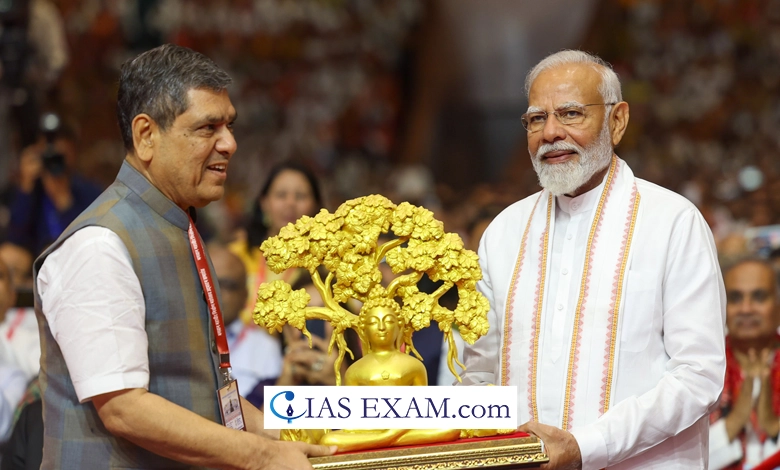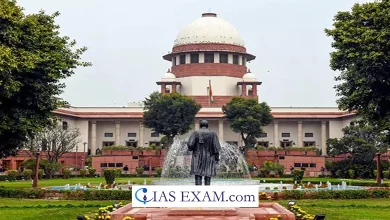Daily Current Affairs for UPSC
2550th Bhagwan Mahaveer Nirvan Mahotsav
Syllabus - History [GS Paper-1]

Context
Recently, the Prime Minister of India inaugurated the 2550th Bhagwan Mahaveer Nirvan Mahotsav on the eve of Mahaveer jayanti at Bharat Mandapam in New Delhi.
Mahaveer Jayanti
- It celebrates the birth of Mahavira, the closing Tirthankara and the founder of Jainism.
- Mahavira was born on the 13th day of the bright half of the Hindu month of Chaitra, which usually falls in March or April.
About Mahavira Jain
- Birth and Early Life:
-
-
- He was born to King Siddhartha and Queen Trishala of the Ikshvaku dynasty, in 540 BC at Kshatriyakund (a part of the widely recognized Vaishali republic) in Bihar.
- He was named Vardhaman, which means continuously increasing.
- He was a kshatriya prince of the Lichchhavis, a collection that was a part of the Vajji Sangha.
- Though he was born with worldly comforts and luxuries, they in no way attracted him and at the age of 30, he left domestic and went to live in a woodland. For twelve years he led a difficult and lonely life.
-
- Kevaljnan
-
-
- At the age of 42 he attained Kevaljnan (omniscience) through right knowledge, right faith and right conduct (Three Jewels of Jainism).
- He was a Jina (conqueror) and the 24th tirthankara.
- Rishabh Deva was the primary tirthankara.
-
- Teachings and Contributions
-
- All living beings have a soul and all souls are equal.
- He puzzled the authority of the Vedas and also emphasized individual agency and suggested the masses to attain liberation from the trials and tribulations of worldly existence.
- This was in marked contrast to the Brahmanical function, wherein, an individual’s life was thought to be decided by his or her birth in a specific caste or gender.
- He delivered one more vow to the four great vows from the time of Lord Parshvanath. The 5 great vows are:
- Ahimsa (non-violence);
- Satya (truth);
- Asteya (non-stealing);
- Aparigraha (non-possession);
- Brahmacharya (chastity, introduced through Mahavira).
- There are two forms of those five vows:
- Mahavrata: The five great vows observed by Jain priests and nuns.
- Anuvrata: The less strict model of notable vows accompanied by using Jain lay human beings.
- As the last Tirthankar, he revived the Tirth (non secular order) and this order is called the Jain Sangh (order).
- Language
-
-
- He used Prakrit language so that ordinary people could understand the teachings as Sanskrit was not understood by many.
- There have been numerous forms of Prakrit, used in distinct elements of the country and named after the regions wherein they had been used.
- For instance, the Prakrit spoken in Magadha was referred to as Magadhi Prakrit.
-
- Death
-
- He attained mahaparinirvana at the age of 70 at Pavapuri near Patna in 468 BC and became a Siddha (free from the cycle of birth and demise).
About Jainism
-
- The word Jain comes from the time period Jina, which means conqueror.
- The simple philosophy was already in existence in North India before the birth of Lord Mahavira.
- According to Jain subculture, Mahavira was preceded by 23 tirthankaras (teachers), literally, those who guide men and women across the river of existence.
- The most critical idea in Jainism is that the whole world is lively and even stones, rocks and water have life.
- Non-damage to living beings, specially to people, animals, flowers and bugs, is vital to Jain philosophy.
- According to Jain teachings, the cycle of birth and rebirth is shaped through karma and asceticism and penance are required to unfastened oneself from the cycle of karma.
- This can be executed only by renouncing the world, consequently, monastic life is a necessary condition of salvation. In order to achieve this, Jain monks and nuns had to take the five vows.
- Seven Tattvas (elements) of Jain Philosophy
-
- Jiva (living substance);
- Ajiva (matter or non-living substance);
- Asrava (influx of Karmic matter in the soul);
- Bandha (bondage of soul by Karmic matter);
- Samvara (stopping of Asrava);
- Nirjara (gradual removal of Karmic matter);
- Moksha (attainment of perfect freedom or salvation).
Source: Indian Express
UPSC Prelims Practice Question
Q.With reference to the religious practices in India, the “Sthanakvasi” sect belongs to (2018)
a) Buddhism
b) Jainism
c) Vaishnavism
d) Shaivism
Ans: “b”





.png)



